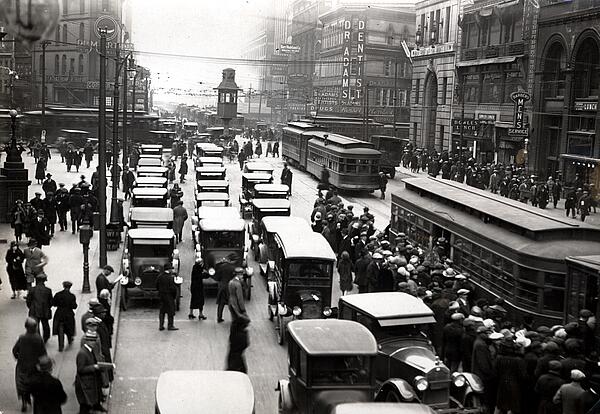America in the 1920's
America in the 1920s is famous for its consumerism, jazz, flappers and prosperity. However, not everybody benefited from this economic boom. More than 60 per cent of American lived below the poverty line, with people in the South suffering the most. Yet, America’s global economic power was unrivalled.
Herbert Hoover’s 1928 presidential campaign slogan was:
“A chicken in every pot, and a car in every backyard.”
This promise summed up the confidence of many Americans who had prospered from US prosperity. The ‘boom years’ were characterised by unprecedented consumption, production and stock market records.
The boom was fuelled by a cycle of mass production and mass consumption. Mass production was made possible with advancements in technology. For example, Henry Ford pioneered the idea of the assembly line in order to mass produce cars. The Ford Model -T has become synonymous with the growth of mass production.

With increased productivity, Ford was able to cut prices, double the minimum wage, and still make a profit. With a higher wage, his employees had more disposable income to spend on these increasingly affordable products. By 1928, 20 per cent of Americans owned a car. Ford manufacturing efficiency and dominance of the market meant that others increased competition, as other companies produced their own cheap cars to compete.
Mass production and mass consumption led to the popularity of other goods. For example, 10 million radios were sold by 1929, while hoovers, fridges and telephones also sold in huge numbers.
The consumer boom was helped by the availability of hire purchase. This allowed consumers to buy goods on credit. It meant that people who could not normally afford luxury goods could buy them, as long as they kept up with the repayments.
In 1928 president Hoover made the bold claim that America had essentially rid itself of poverty. However, there was a huge inequality of wealth in 1920s America. African Americans, farmers and sharecroppers suffered great hardship during the decade.
Although slavery had technically been abolished, African Americans still remained oppressed, particularly in the south states where they were forced to do menial labour for very poor wages. Not only that but to make matters worse African Americans were also racially attacked by the KKK on a regular basis. Many African Americans tried to escape segregation and poverty in the South by migrating to northern cities in the Great Migration.
However, even in the North many black families worked menial jobs and lived in ghettos in very poor conditions. The Harlem Renaissance was an African American cultural movement that grew out of this racial inequality. It celebrated Black culture, including literature and jazz. However, this cultural liberation was out-of-reach for most African Americans.
Another group that was excluded from prosperity was the sharecroppers of the South and Midwest. The sharecroppers were those who rented land or bought it using a mortgage. However, if they had a bad harvest or the price of food went down they would struggle to make the necessary payments, which would result in them being evicted off of the land.
Indeed as the 1920s progressed this became increasingly commonplace; farmers also suffered as overproduction led to a fall in the value of crops. Not only did they struggle to sell their crops in the saturated American market, but due to trade tariffs it was not possible for them to sell their produce overseas in Europe. As a result, many farmers in the Midwest were evicted from their farms, which were also their homes. This in turn gave rise to hobos, which was the name given to the men who who would roam around the mid-American states on trains in an attempt to find part-time work.
Amidst the supposedly ‘roaring 20s’, the African Americans and renting farmers were the ones left behind. Meanwhile, the other areas of society were left, if anything, with too much money, which led to mass consumption and the beginning of the stock market, with people investing their money in stocks and shares.
It is estimated that by 1929, over 1 million people owned shares in America, but this would all go wrong when in October 1929 the Wall Street Crash happened.
MLA Citation/Reference
"America in the 1920's". HistoryLearning.com. 2026. Web.
